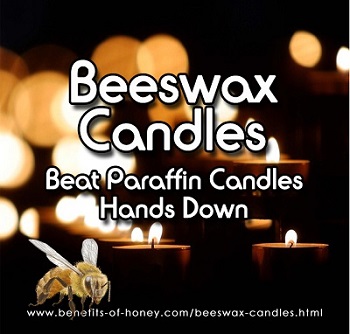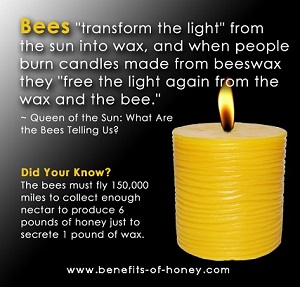beeswax candles
Why Switch to Beeswax Candles – 10 Great Reasons (#8 is Wow!)
“These beeswax candles are so costly compared with regular candles, any reason why I should use them apart from their natural aesthetic value?”
Like most of you, I have popped this question when I noticed that these candles have a much bigger price tag compared to those at Ikea.
If you are currently burning candles at home and price is not always the the number one reason for these stuff, there are many good reasons for you why candles made of beeswax are so much more superior and why you should switch to these candles.
Beeswax Candles Versus Paraffin Candles
1. Supply and Price

Beeswax costs about 10 times more than paraffin. It is estimated that the bees must fly 150,000 miles to collect enough nectar to produce six pounds of honey just to secrete one pound of wax. And for every 100 pounds of honey harvested, the beekeeper can only obtain about 1-2 pounds of the beeswax. Hence beeswax candles are rare and expensive.
Easily available and cheap, paraffin candles make up 95% of the world’s candle production. A pack of 100 paraffin tealight candles from Ikea costs less than ten bucks.
2. Amount of Chemical Compounds
Created by the bees, beeswax candles are 100% natural, all chemical-free. They are the oldest candles known to man and prized since ancient times. (Caution: There are no regulations on disclosing candle ingredients. Candles labelled as “beeswax” may be predominantly made of paraffin and contain as little as 5% beeswax. Look for “100% pure beeswax candles”.
Paraffin candles are an oil-based, highly refined petroleum by-product that contains up to 11 toxic compounds and chemicals such as benzene and toluene. They emit toxic diesel exhaust-like fumes.
3. Environmental Friendliness

100% beeswax candles are natural, environmentally friendly, safe, and non-toxic as they undergo no chemical processing and are biodegradable. Being non-oil-based, they burn very clean with little smoke when trimmed properly.
Paraffin candles on the contrary, are a black sludge that is treated with 100% industrial strength bleach to change its color to white, creating toxic dioxins. Acrolyn, a carcinogenic chemical is then added to solidify the white sludge. The end result is an extremely toxic product. By burning these candles, you produce the same toxins. If you really know how poisonous paraffin candles are, you would dump them and stop polluting the air in your home.
4. Natural vs Artificial Fragrances
Beeswax candles smell great as they are naturally scented by the honey and floral nectar in the honeycomb; theya re carbon-neutral. Paraffin candles however, contain artificial dyes and synthetic fragrances which also produce toxins and stains when burned, adding to the environmental damage. Some paraffin candles also contain lead wicks.
5. Burn Time
With a high melting point (in fact the highest among all known waxes), beeswax candles have significantly longer (2-5 times) burn time and drip very little, if any at all. This offsets their higher cost. Paraffin candles on the other hand, are not as efficient. They are short burning and drip excessively, which means that they may not be that economical after all. Some of these candles even have additional chemicals added to reduce dripping.
6. Brightness
Beeswax candles burn stronger and brighter. Emitting naturally bright light of the same light spectrum as the sun (Green Rhino Spectrum, Solar Spectrum), they are a gift from nature! Paraffin candles produce a flame that is not as strong and brilliant, and cannot evoke the same natural ambience of warmth and style as beeswax.
7. Blooming with Age
Beeswax candles burn with even more beauty with age. Over time, beeswax develops a white film (especially in cooler climate), which is deemed as a very desirable feature. Synthetic waxes do not bloom as time passes.
8. Negative Ions vs Black Soot
Beeswax candles are the only candles that emit negative ions that purify, cleanse, improve air quality, and invigorate the body. They are a natural ionizer! Paraffin candles produce harmful black soot that leaves streaks of black residue and stains home interior surfaces.
9. Benefits to Those with Allergies or Asthma
Hypo-allergenic, beeswax candles benefit those with environmental allergies, sensitivities, and asthma. Paraffin candles are to be avoided by those with allergies or asthma conditions.
10. Origin
While beeswax candles originate from a renewable fuel, beeswax, paraffin ones originate from a non-renewable resource, petroleum.
All the pictures of the candles you see in this video (left) are made of pure beeswax. I fell in love with these candles after discovering that their performance beats the paraffin candles hands down. And I also have to agree with what I have found in my research – that these lovely candles do burn more brilliantly, cleaner and longer! So, stop burning petroleum and polluting your home. Turn to beeswax. It will make a difference in your home ambience and the quality of life of those who love candles.
100% Beeswax Candles
Hang on, what about soy candles? Don’t they make a healthy choice as well? Like paraffin wax, soy candles have a lower meting point and hence do not burn as strong and bright as beeswax candles. But the biggest drawback of soy candles is that they will spoil without preservatives. Additives, bleach and hardeners are common ingredients of soy candles. Also, soy candles are mostly made from genetically modified soy crops that are heavily sprayed with toxic pesticides.
Wind down, light some therapeutic beeswax candles, curl up in the sofa with a cup of hot tea and let the stress of the day melt away.
To your excellent health,
Ruth Tan
Related Pages:
2. Get Beeswax Candle Care Tips
3. How to Make Beeswax Candles
4. If you are located in Singapore, check out our handmade beewswax candles at: Bee Healthy
5. Bee Wax Uses You Probably Don’t Know
6. Honey Bees and Their Wondrous Products